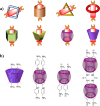Bridging host-guest chemistry with molecule chemistry-covalent organic polyrotaxanes (COPRs): from synthesis to inactivation of bacterial pathogens
- PMID: 39318465
- PMCID: PMC11420781
- DOI: 10.1039/d4ra05381h
Bridging host-guest chemistry with molecule chemistry-covalent organic polyrotaxanes (COPRs): from synthesis to inactivation of bacterial pathogens
Abstract
As a thriving artificial material, covalent organic frameworks (COFs), boasting inherent structural designability and functional adaptability, and with compositions akin to biological macromolecules, have emerged as a rising star in the field of material science. However, the progression of COFs is significantly impeded by the arduous and intricate preparation procedures of novel building blocks, as well as the inefficient development process of new reactions. An efficient, uncomplicated, and versatile functionalization approach, which has the potential to not only facilitate customized preparation of COFs based on application demands but also enable precise performance control, has become a focal point of research. The formulation of multi-functional COFs through efficient and cost-effective methods poses a critical challenge for the practical application of COFs. This review aims to present the preparation of COFs by amalgamating rigid molecular chemistry with flexible supramolecular host-guest chemistry, adopting a "couple hardness with softness" strategy to meticulously construct intelligent covalent organic polyrotaxanes (COPRs) using conventional reactions. Herein, novel building blocks can be acquired by amalgamating existing macrocycle complexes with framework blocks. The amalgamation of supramolecular chemistry bolsters the capabilities to generate, sense, respond, and amplify distinctive signals, thereby expediting the advancement of multifaceted materials with sophisticated structures. Concurrently, the infusion of supramolecular force endows COPRs with exceptional performance, facilitating multi-mode collaborative antibacterial therapy. This comprehensive review not only promotes the efficient utilization of resources but also stimulates the rapid advancement of framework materials.
This journal is © The Royal Society of Chemistry.
Conflict of interest statement
There are no conflicts to declare.
Figures









References
-
- Wang Z. Liu X. Duan Y. Huang Y. Infection microenvironment-related antibacterial nanotherapeutic strategies. Biomaterials. 2022;280:121249. - PubMed
Publication types
LinkOut - more resources
Full Text Sources
Research Materials

